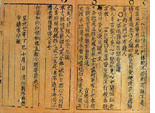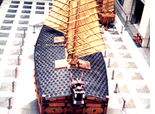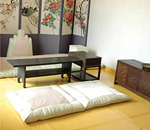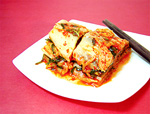|
 |


|
 |

Baegun hwasang chorok buljo jikjisimcheyojeol
(Vol.II), the second volume of "Anthology of Great Buddhist Priests'
Zen Teachings"
Jikjisimcheyojeol, often abbreviated as Jikji,
is the world's oldest text printed with metal type,
predating by some 70 years
Germany's Gutenberg Bible published in 1455.
Jikji is a collection of Buddhist treatises and
teachings compiled by the ancient monk
Baegun at Heungdeok-sa Temple in Cheongju,
North Chungcheong Province, in July 1377.
Originally two volumes, only its latter volume is
still extant.
It is in the possession of the National Library of
France in Paris. Jikji was inscribed in the Memory
of the World Register in September, 2001,
in an effort to preserve its documentary heritage
as a common heritage of humanity.
For more information, click here
|
| |
 |


|
 |

Geobukseon is a battleship engineered by a cientist
at the order of Admiral Yi Sun-sin of the Joseon Dynasty, Korea's most-revered hero.
"Turtle" is "geobuk" in Korean, and the similarity in appearance between these two hard-shelled
creatures explains the name. The upper deck was covered with a rounded wooden roof that itself was studded with pointed iron spikes to repel enemies trying to board.
During the war, Admiral Yi Sun-sin won every one
of at least 23 naval battles he fought, boasting an unprecedented record of victories. Admiral Yi has
often been compared with Lord Nelson, the British
hero who triumphed over the French-Spanish fleet at the Battle of Trafalgar. Both admirals fought for the destiny of their countries and saved their countrymen from foreign invasion by securing key naval victories.
Recognized as a breakthrough in military technology, Geobukseon replicas are on exhibit
in a number of national museums, including the War Memorial of Korea, the War Memorial Museum in the U.S., the National Maritime Museum in England and historical museums in China, Germany and other countries.
For more information, click here
|
| |
 |
 |
 |
 Ondol is a uniquely Korean heating system that can be traced back to the ancient kingdom of Goguryeo. Unlike Western heaters that generally warm the air, ondol heats the floor of a room.
Invented by ancient Koreans, the original system
worked by heating a large stone under a living space: Smoke from a fire just outside the dwelling was forced under the stone and exited on the other side.
The system survives today in modern houses and
apartments where water heated in gas or electric boilers is circulated through pipes encased in cement floors. |
| |
 |


|
 |

Just as Germans relish sausages, Indians curry,
Italians pizza, the Korean people love kimchi.
A staple that accompanies Koreans on journeys
across the world, kimchi is a pungent,
fermented dish made from a range of
vegetables-cabbage, cucumbers, seasoned
with salt, garlic, green onions,
ginger, red chili pepper and other herbs and spices.
It may be savored as it is or used as an
ingredient in a wide variety of dishes.
On July 5, 2001, kimchi was approved as an
international standard
by the Codex Alimentarius Commission (CAC),
an international organization in charge of
setting up internationally available food
standards with the goal of promoting
the trade of food items. Furthermore,
an American monthly magazine Health,
selected kimchi as one of the world's
five healthiest foods in its March online edition.
According to the magazine, kimchi is rich in
Vitamins A, B and C and bacteria lactobacilli,
healthful bacteria that aid digestion.
|
|
|


